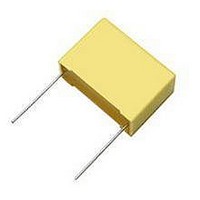MKT1826510066 Vishay, MKT1826510066 Datasheet - Page 4

MKT1826510066
Manufacturer Part Number
MKT1826510066
Description
CAPACITOR POLYESTER FILM 1UF, 63V, RADIAL
Manufacturer
Vishay
Datasheet
1.MKT1826247014.pdf
(18 pages)
Specifications of MKT1826510066
Capacitor Application
Safety / Suppression
Capacitor Dielectric Type
Polyester
Capacitance Tolerance
± 20%
Voltage Rating
63VDC
Capacitor Case Style
Radial Leaded
Capacitance
1µF
Tolerance
20 %
Termination Style
Radial
Lead Free Status / RoHS Status
Lead free / RoHS Compliant
FILM CAPACITORS
Plastic film capacitors are generally subdivided into film/foil
capacitors and metallized film capacitors.
FILM/FOIL CAPACITORS
Film/foil capacitors basically consist of two metal foiI electrodes
that are separated by an insulating plastic film also
called dielectric. The terminals are connected to the end-faces
of the electrodes by means of welding or soldering. Film/foil
capacitors are typically manufactured in C-values ranging from
100pF to 0.01µF.
Main features: High insulation resistance, excellent current car-
rying and pulse handling capability and a good capacitance
stability.
METALLIZED FILM CAPACITORS
The electrodes of metallized film capacitors consist of an
extremely thin aluminum layer (0.02µm - 0.1µm) that is vacuum
deposited either onto the dielectric film or onto a carrier film.
The dielectric film materials currently used in production range
from 0.9µm to 20µm. The opposing and extended metallized
film layers of the wound capacitor element are connected to
one another by flame spraying different metals to the end-
faces. The metal spraying process is also known as schooping.
The terminals are connected to the end-faces by means of
welding or soldering.
For the production of metallized film capacitors Vishay
Roederstein uses both the conventionally wound film and the
stacked film (multilayer) technology. Stacked film capacitors,
compared with wound film capacitors, exhibit a higher pulse
load.
Metallized film capacitors are typically manufactured in
C-values ranging from about 1000pF to 10µF.
Main features: High volume efficiency, self-healing properties.
SPECIAL CAPACITOR DESIGNS
For high current applications Vishay Roederstein is also able
to offer special designs such as capacitors with a heavy edge
metallization or a double sided metallization as well as
combinations that have a film/foil and a metallized film design
in one unit. For high voltage applications it is furthermore pos-
sible to offer designs with dual and multiple sections.
Depending on the design these capacitors provide low
losses, high current and pulse carrying capabilities, high volt-
ages, small dimensions and good self-healing properties.
General Technical Information
Vishay Roederstein
www.vishay.com
6
For technical questions, contact dc-film@vishay.com
Film Capacitors
SELF-HEALING
Self-healing, also known as clearing, is the removal of a de-
fect caused by pinholes, film flaws or external voltage
transients. The heat generated by the arcing during a break-
down, evaporates the extremely thin metallization of the film
around the point of failure, thereby removing and isolating the
short circuit conditions.
Stacked film capacitors exhibit due to their homogeneous and
their relatively low winding-pressure between the layers out-
standing self-healing properties.
The self-healing process requires only µW of power and a
defect is normally isolated in less than 10µs. Extensive and
continuous self-healing (e.g. at misapplications) will gradually
decrease the capacitance value.
DIELECTRIC MATERIALS
The electrical characteristics of plastic film capacitors are to a
great extent dictated by the properties of their dielectric mate-
rials. Vishay Roederstein uses the following film materials in
their production:
POLYETHYLENE TEREPHTALATE FILM OR
POLYESTER FILM (PET)
Polyester film offers a high dielectric constant, and a high di-
electric strength. It has further excellent self-healing pro- perties
and a good temperature stability. The temperature coefficient
of the material is positive.
Polyester capacitors are regarded as “general purpose ca-
pacitors”. They provide the best volume efficiency of all film
capacitors at moderate cost and are preferably used for DC
applications such as decoupling, blocking, bypassing and noise
suppressions.
POLYPROPYLENE FILM (PP)
Polypropylene film has superior electrical characteristics.
The film features very low dielectric losses, a high insulation
resistance, a low dielectric absorption, and a very high diel-
ectric strength. The film provides furthermore an excellent
moisture resistance and a very good long-term stability. The
temperature coefficient of the material is negative.
Polypropylene capacitors are typically used in AC and pulse
applications at high frequencies (e.g. fly-back tuning and
S-correction). They are further used in switched mode power
supplies, electronic ballasts and snubber applications, in fre-
quency discrimination and filter circuits as well as in energy
storage, and sample and hold applications.
POLYCARBONATE FILM (PC)
Polycarbonate film exhibits low dielectric losses, and a very
good long term stability. Its temperature coefficient is very low.
Polycarbonate film capacitors are preferably used in filter, tim-
ing and integrating applications.
Document Number 26033
Revision 01-Dec-03











